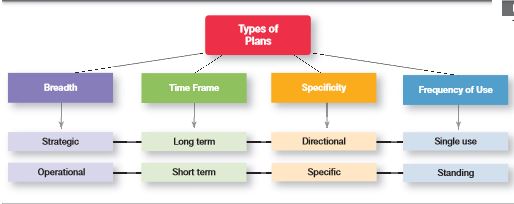8.2 Goals and Plans
In order to executive any type of managerial decision effectively, a decision maker has to chalk out all the necessary steps to be followed, the workforce to be assigned and their roles, and analysis of the overall implementation and expected outcomes. Planning provides the basis for all other subsequent managerial functions. It is a primary function that generally consists of two parts:
- Plans: plans are detailed proposal with the sole purpose of achieving a goal. These are courses of action and processes that describe how a goal is to be achieved. Resource allocation, work team specifications, and scheduling are all part of formulation of a plan. All documents that outline the path to reach the specified goals are plans.
- Objectives: the ultimate return on every decision is the fulfillment of the objectives they were meant to satisfy. They are the essential elements of planning, the foundation and criterion on which all subsequent decisions are based on. Knowing the target that needs to be satisfied is very essential in order to formulate an effective plan.
Developing both the plans and the goals to be achieved by them is very important in effective situational management. Planning is an entire procedure starting from the identification of the problem to the implementation and regulation of the suitable alternative solution.
Classification of goals
All business have a corporate objective: whether it is to make profit or to help out the disenfranchised constituents. However, having a single goal can narrow the vision of managers, who will look to ignore other relevant facts and make unethical choices which can lead to catastrophic after-effects. Most organizations have a specific list of goals stated in their company vision. This keeps the staff members interested in their jobs, and provides opportunity for varied and unique problem solving. A company mission is the stated list of its objectives, future endeavors, moral standings, social and corporate responsibilities, and overall workplace motto.
A company’s goals that are stated in the manifesto are generally twofold:
- Financial goals: those goals concerned with boosting the profits and ensure better market returns. These are mostly informational in nature and require analysis and interpretation of all available info for best results.
- Strategic goals: the goals which focus on overall improvement of the organization apart from realizing financial goals. Many organizations take part in arranging and outreaching the disadvantaged population, providing them with basic amenities to push up their quality of life as well as the company byline.
The ones mentioned above are just for forwarding the company line and keep the stakeholders at ease. Also known as stated goals, these are frequently published in annual reports, PR campaigns, any place where the shareholders would try and understand the company better before investing. These goals are often catchy and interesting, designed to draw in investors. Most of the time they are just words and do not reflect the actual mindset of the company.
Coming up with a good mission statement is nothing more than a advertorial endeavors, designed to trick investors into believing that they are actually making a difference by aligning themselves with eh concerned corporation. The real goals of an organization can be found by communicating with the employees, the managerial staff and the executives for a comprehensive understanding of their true purpose. Real goals of an organization can be deduced by observing the members. As organizations tend to prioritize their actions, knowing the difference between stated and real goals is essential for recognizing inconsistencies, and also for streamlining organizational flow.
 Classification of plans
Classification of plans
Although many think that an organization only prioritizes profiteering and maximum return on investments, but modern corporations are far more nuanced and finely calibrated that traditional companies. Today, equal emphasis is laid on developing the social standing of the company as well as their bottom-line. Corporate social responsibility plays a crucial role in integration of business with contemporary society.
Planning in organizations can be classified broadly depending on four factors:
- Breadth: a plan can either be for the entire corporation or any particular unit that it doing a specific task. Generally two types of plans are prevalent based on their scope:
- Strategic plans are applicable to the entire company and used for goal orientation. This includes overall developments, new legislative enforcement, expansion of offices.
- Operational plans focus on a particular operation or group of operations. This includes specialized task forces, focus groups and expert teams to carry out a particular job best suited to their specific expertise.
- Time: the time taken for the plan to affect performance is critical while formulation of the plan. The managers use the time taken to formulate a complete plan and divide it in two groups:
- Long term plans: these are the plans that take more than 3 years to be properly put into action and show results. Most plans made for overall economic growth, as well government plans meant to be rolled out in succession are examples.
- Short term plans: they are plans that are made for durations less than a year. Short term plans are formulated of temporary situations like relocation due to repairs, unexpected maintenance and security check etc.
- Frequency: all events encountered in management require either a repeated procedure or a customized solution. Plans are classified by the number of times they can be used.
- Single use: it is a unique plan that tackles an unprecedented situation, and is unlikely to be repeated. Single use plans are generally used in unforeseen circumstances, and the conditions that define it are pertinent only to the problem at hand.
- Standing plans: in every business venture, there process that need to be done repeatedly and over a long duration of time. Standing plans are made for repeated and similar activities, which helps prevent repeated analysis of the same situation instead of just implementing the established best alternative. Policies, rules and protocols are examples of this type of plans.
- Specificity: sometimes many problems occur that are similar in nature, but require a unique solution. Planning can wither be used to formulate the steps on to follow, or lay down specific orders to complete the task.Hence, plans are also classified by their clarity and specificity:
- Directional plans: these are flexible plans that dictate the guidelines to deal with a particular situation rather than specifically solving a problem. Policies are a relevant example of this type of decisions. If the situation is familiar, but cannot be solved using a fixed step of operations, the particulars of the decision are left up to the manager, providing him with a general guideline to help formulate it better.
- Specific plans: these are detailed plans specifying all the relevant constraints and condition required to tackle a unique problem. When the problem is well defined and there is a clear way to solve it, specific plans are made with clear outline and specification of each step to maximize the efficiency of the solved problem.
Links of Previous Main Topic:-
- management and organizations a managers dilemma
- Understanding managements context constraints and challenges
- Managing in a global environment
- Managing diversity
- What is social responsibility
- Managing change and innovation
- Managers as decision makers
- Foundations of planning
Links of Next Fundamentals of Management Topics:-
- Different approaches for goal setting
- Effective planning in contemporary business
- Case application 1 icelandic volcano 1 global commerce 0
- Case application 2 building a future
- Chapter eight summary by learning outcomes
- Preparing for my career in chapter eight
- Strategic management
- Basic organizational design
- Adaptive organizational design
- Managing human resources
- Managing teams





